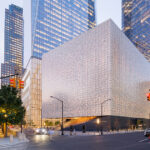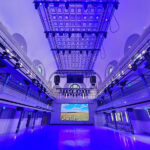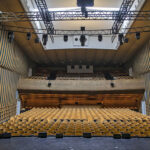All load-ins are a testament to the beauty of cooperation and madness. This gets amplified when you’re putting up the set as they’re finishing the theatre.
“They’re kind of building around us,” says Jim Fedigan, production electrician for the install of Jersey Boys in the Jersey Boys Theatre at the Palazzo Las Vegas — Resort, Hotel, Casino. We’re standing on the lip of the stage looking at lights that have been hung onto truss, and then wrapped in plastic bags to protect them from construction dust, which is everywhere. Fedigan started the load-in in a theatre that was far from complete.
“Normally, after the first week I’d be finished with everything I had to do and I’d be ringing out circuits,” Fedigan says. He gestures at the audience area, where workers are installing frames for the seats. “But this show is just a slow and steady process.”
Three weeks later and I’m sitting in those seats (now installed and free of dust) talking with Steven Ehrenberg, VP of technical production for BASE Entertainment, one member of the producing entity that brought Jersey Boys to Vegas. Ehrenberg’s self-described job is to act as the producer’s representative when dealing with the Palazzo, their architects and consultants, ensuring that the creative and technical team has everything they need to mount a successful production. It’s a job that requires him to gather the technical info the production team needs in order to fit the production into the theatre, coordinate that with the architects and builders, and make sure that it all passes city inspection. Along the way he has to deal with conflicting, and sometimes incompatible, schedules.
“I’m always playing in the world of difference between the construction schedule, which is 12 months out, and the production schedule, which is more like 12 weeks out,” says Ehrenberg. But it’s even harder than that. The architectural drawings were done more than five years ago, when there was no specific show to design for, and so the original design of the theatre was a Vegas-style showroom model that the casino architects had made for planned casinos in Macau and other Asian locations. The theatre had a large cross-aisle with a hard tear-wall separating the front and back of the orchestra section, a balcony which sat fairly far back from the proscenium, a stage deck designed like a regular floor and a backstage that was designed to support a hotel kitchen.
“So there were some serious challenges coming here,” quips Ehrenberg.

One of the first things the producers insisted on doing was pulling the balcony closer to the stage, eventually getting the lip of the balcony less than 60 feet from the proscenium. In a normal Vegas showroom the lip can be 100 feet or more from the proscenium. The director, Des McAnuff, and the producers wanted to keep the space intimate for what Ehrenberg describes as a “small show.”
But the steel had already been bought. If they pulled the balcony forward, the support steel couldn’t be redesigned, so the balcony support columns also had to move forward. The result is two large columns that push into the back of the orchestra section a few rows. They are spaced the same width as the control booth that sits at the back of the orchestra seating, and the framed area has become the audio front of house mixing position. But it still rankles Ehrenberg.
“I was like, ‘I hate them, I hate them,’” he says. “But if that’s what it takes to move the balcony forward…”
They also eliminated the cross-aisle and tear wall from the drawings, which enabled them to pull the last row of orchestra seats 15 feet closer to the stage.
Casino operations impinged on the stage footprint.
“I’ve got a stairway that’s totally encroaching on the stage left space,” says Ehrenberg. “I’ve got a stairway in the basement on stage right. They put a kitchen in half of the basement — all done when the building was designed — that services the ballrooms. That’s got half our footprint under the stage. All of which is traditional backstage area. Gone.”
They’ve managed to make it work, but wardrobe is tight, and more dressing rooms would have to be installed if a show with a larger cast ever moves in.
But perhaps the biggest problem with the stage is the stage itself. It was built like a normal hotel floor, with concrete poured over the structural steel. There was no way to trap it, and Ehrenberg was told that they couldn’t rebuild the stage. It would require putting too much structural steel back in to retain structural integrity; the steel would cost money they didn’t have and installing it would take time they didn’t have.
So Ehrenberg was left trying to figure out how to make trap doors for the drum lift, mic lift and scenic elements that pop through the floor. Working with Erik Tuomy, the on-site rep from HKS Architects, they came up with a way they could cut through the steel and concrete of the stage floor enough for the lifts they needed. All Ehrenberg would have to do is figure out where to place the lifts. But because he was working on a construction schedule, while the producers and director were working on a show schedule, he had a hard time getting them to commit to a place where they wanted the traps to go on the new-sized stage.
“They kept saying, ‘No, all we want is a big open stage and a big open hole in the middle of the stage that’s trappable,’” relates Ehrenberg. “I said it’s not built that way; it won’t be built that way.”
Finally, working off the Broadway set plans, he cut a 10’-by-10’ hole in the stage for the drum lift. This was bigger than necessary for the trap, but Ehrenberg was trying to leave enough room to shift the lift slightly if Director Des McAnuff wanted to move it. Ehrenberg also worked with the engineer to create the other necessary traps and preserve all the director’s staging.
While the stage may have given everyone fits, the process of cabling up the theatre for lights and control went considerably more smoothly. Buddy Pope at 4Wall handled the electrical install, with Pat Best working as steward for the electricians. The show uses an ETC dimming system, ETC SmartSwitches and ETCNet2 to distribute control signals. An ETC Obsession console sends MIDI to synch with two MA Lighting grandMA consoles — a main and a backup — and to trigger video content and live camera cues. All the conventional fixtures, scrollers, MDG Hazers and star strobes are also controlled by the Obsession. The High End Systems AF-1000 Strobes, all portal Color Kinetics ColorBlast LEDs, under-bridge ColorBlaze LEDs and Vari-Lites are controlled by the grandMAs.
In terms of the lights, Fedigan describes it as “a pretty simple rig,” heavy on Vari*Lite VL2500 Spots and Washes.
“There used to be tons of PAR cans in here, but they added these movers, and they do everything that the PARs were doing,” says Fedigan. The VL2500 was a hit with director McAnuff because of the low fan noise.
“It’s a book musical with a lot of quiet scenes,” Fedigan notes. “And he didn’t want the fan noise going all over it.”
Some practicals are controlled using a City Theatrical Wireless Dimming System. City Theatrical also supplied the donuts to mask the PARs in the stadium wall for the first act closing number.
“The stadium wall is our baby,” says Fedigan. “We got donuts from City Theatrical in there made to increase in size. So it looks like this huge perspective with the walls coming out.”
Color Kinetics ColorBlast72s line the front edge of the bridge set piece to add fill and effects to the performers when they’re behind the mics downstage, and ColorBlast 6s are used for truss warmers on the side proscenium portals. They are placed every 10 feet in the steel structure, focusing up and down.
“It gives it a nice a tone, plus we’re getting different color chases through them now,” explains Fedigan. “In New York, we have a scroller mounted to the bottom in the floor and scroller at the top. Basically that does everything. Up here, it’s Vegas, so we’ve got to triple it up.”
One of the most noticeable additions to the show was the incorporation of more video screens. The show added two LED video screens on either side of the house, flanking the stage and two more video screens that fly downstage-center during intermission — sorry, “The short break.”
While casino officials wanted the show intermission-less in order to shorten its running time and return patrons to the gambling floors more quickly, the producers and creative team lobbied hard to keep the intermission to give a sense of the passage of time. In the end a compromise was struck. Two new center LED video screen arrays fly down from the rigging at the end of Act One. A smaller array made up of 12 Lighthouse R-10 panels (approximately 2.5m wide by 2m high) shows a clock counting down the time until the short break ends, while a larger wall below the clock, made up of 28 Lighthouse R-16 panels (approximately 7m wide by 3m high) shows vintage road trip footage, which is meant to evoke the life of the Four Seasons on the road and their travels to Vegas. This content is integrated with two new additional screen arrays stage left and stage right of the proscenium. These arrays are also made up of the R-16 panels and measure approximately 4m wide by 3m high. Pete’s Big TV’s supplied the LED walls, while the Sound Associates manages the front end of the video system and also supplies the content.
The video is distributed via a Dataton Watchout system, with three different Medialon systems running content: one for the show, one for backup and one to run the break footage. Cues are run off MIDI that the consoles supplies to the Medialon, but sound sends SMPTE signal to video for both the intermission sequence and the end of show finale video content.
Jersey Boys starts with a French hip-hop rendition of “Oh, What a Night” and ends with the crowd leaping to their feet. If they knew what the production team went through to deliver such a fine theatre, they’d start the show with a standing ovation, too.


